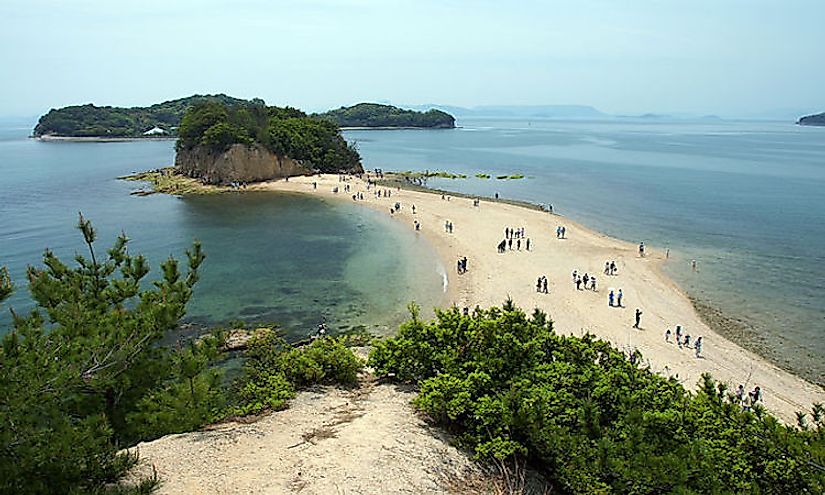Coastal Landforms: What Is A Tombolo?

What Is A Tombolo?
A tombolo is a coastal formation that means, when translated from Italian, “mound”. It appears to be a small island that has not fully separated from the mainland. This island-like landform is actually attached to the coast by a thin sand bar or spit. Tombolos are sometimes referred to as “tied islands”, because it seems to tethered to the coast. These formation can be either solitary or found in clusters. When clustered, the sand bars may form a lagoon-like enclosure near the coast. These types of lagoons are likely to fill with sediment over time.
How Is A Tombolo Formed?
Longshore Drift
Longshore drift occurs as waves push sediment (which may consist of sand, silt, and clay) towards the coastline at an angle. Instead of landing on the beach, this sediment begins to build up between the beach and an island, creating the bar mentioned above and effectively “tying” the island to the mainland. This drift is often influenced by the wind direction. When created by longshore drift, these formation are sometimes not considered a true tombolo.
Wave Diffraction And Refraction
A true tombolo is formed by wave diffraction and refraction. Waves move toward the coastline and are slowed down as they enter the shallower water. They first reach the islands that are close to the shore. Because these waves are moving at a slower than normal pace, they move around the island instead of over it. As the water moves more slowly around the island, it picks up sediment along the way. When the waves meet on the other side of the island (the side facing the coast), the sediment is deposited. This sediment continues to build up until it creates the sandbar that connects the island to the beach.
Changing Tombolos
Because of the unique shape of tombolos, they tend to be more likely to change over time due to weathering and tides than the regular coastline. Sometimes, the island at the end of the bar, or spit, is large enough that it supports commercial or residential activity. In order to prevent changes to the tombolo, the bar is reinforced with cement roads or parking lots. This prevents wind and waves from washing away the finer sediment on top of the bar.
Tombolos Around The World
One of the most well-known tombolos around the world is Chesil Beach, located on the southern coast of Dorset in England. This beach connects to the Isle of Portland, a 4-mile long, limestone island. It is an inhabited island with a population of around 12,400. The island and the beach belong to the Jurassic Coast, a UNESCO World Heritage Site, which is protected due to its unique geological formation. Some scientists, however, have suggested that Chesil Beach is not actually a true tombolo. Additionally, this site is an important bird nesting area between April and August; access to several areas here is prohibited during this time.
Another well-known tombolo is the Aupouri Peninsula in New Zealand. It is located on the northern side of the North Island, between the Tasman Sea and the Pacific Ocean. This site is interesting because it is a peninsula within a peninsula, making up part of the North Auckland Peninsula. This tombolo creates the Rangaunu Harbour, as well as several other harbors along its length.







